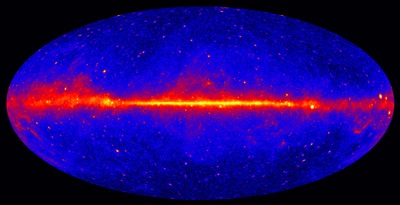The Fermi Science Support Center (FSSC) runs the guest investigator program, creates and maintains the mission time line, provides analysis tools for the scientific community, and archives and serves the Fermi data. This web site is the portal to Fermi for all guest investigators.
instrument on NASA's Fermi Gamma-ray Space Telescope. Brighter colors indicate brighter gamma-ray sources.
Image Credit: NASA/DOE/Fermi LAT Collaboration
Look into the "Resources" section for finding schedules, publications, useful links etc. The "Proposals" section is where you will be able to find the relevant information and tools to prepare and submit proposals for guest investigator projects. At "Data" you will be able to access the Fermi databases and find the software to analyse them. Address all questions and requests to the helpdesk in "Help".
Quicklinks
- » Fermi Homepage
- » Fermi Summer School
- » LAT Analysis Start Page
- » Multiwavelength Observation Reporting Form
- » Fermi User's Group (FUG)
- » Fermi Guest Investigator Program
- » Post-Anomaly Observing Strategy
- » Fermi TOO request
- » LAT Monitored Sources
- » LAT Instrument Performance
- » GBM Instrument Performance
Fermi Observations for MW 843
Mission Week 843 begins with a continuation of the asymmetric +50/-60 deg. profile from the previous week. Then, on DOY 207 (2024-7-25) at 02:03 UT a 10-minute freeze observation occurs during which an asymmetric +50/-60 deg. profile is loaded. Next, on DOY 209 (2024-7-27) at 17:22 UT a 10-minute freeze observation occurs during which a +50 deg. modified sine profile is loaded. This profile continues until the end of the mission week. The survey repeat period is based on a 5690s orbital period. Note that positive rock angles are south, and negative rock angles are north.
Latest News
Jul 25, 2024
NASA's Fermi Finds New Feature in Brightest Gamma-Ray Burst Yet Seen Summary
In October 2022, astronomers were stunned by what was quickly dubbed the BOAT - the brightest-of-all-time gamma-ray burst (GRB). Now an international science team reports that data from NASA's Fermi Gamma-ray Space Telescope reveals a feature never seen before.
+ Read More
Jun 6, 2024
Announcement of the Gamma-ray Data Tools (GDT)
The Gamma-ray Data Tools (GDT) is an open-source Python-based centralized toolkit for analyzing data from space-based hard X-ray and gamma-ray instruments. The GDT borrows its heritage from, and supersedes, the Fermi GBM Data Tools. The GDT is designed with a "core" package that contains generalized functionality and base classes that are utilized by a variety of mission packages. For more information see the GBM Software Page.
Jun 5, 2024
Fermi Cycle-17 GI Program Selections Announced
The stage-I selection process for the Fermi Cycle-17 Guest Investigator program has been completed. There were a total of 37 new programs selected out of 113 proposals submitted. A list of the selected programs, including the PIs, titles and abstracts is available on the FSSC web site.



